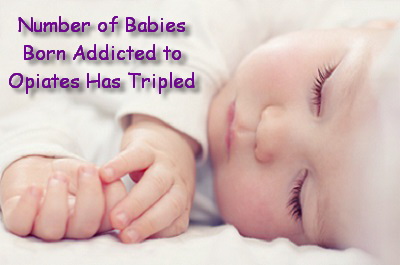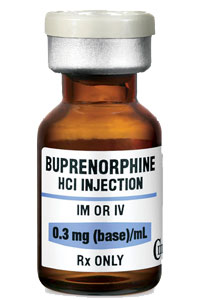You would be forgiven for thinking that the prescription drug epidemic affects only the users themselves. Abusing medicines such as Vicodin and OxyContin—opiate drugs with chemical similarities to heroin—puts the users at significant risk, killing more Americans than heroin and cocaine combined in 2008; but using when you’re pregnant presents a whole new class of risks. Babies of opiate-using mothers can be born in withdrawal, their systems shocked by the abrupt withdrawal of substances, and research has revealed that this is happening more and more frequently in the United States. In fact, three times as many babies were born with neonatal abstinence syndrome (NAS) in 2009 than in 2000, reflecting the rapid rise in the prescription drug problem.
The Study
Lead researcher Dr. Stephen Patrick had noticed an increase in the number of babies with NAS at CS Mott Children’s Hospital at the University of Michigan, and set out to determine whether the numbers were also increasing across the country. The researchers looked at discharge records from 2000, 2003, 2006 and 2009 from a database of patients that covers 44 states and over 4,100 hospitals. When the researchers determined which of the births were associated with opiate use, they revealed some shocking statistics about the extent of the problem.

They found that the number of pregnant women abusing opiate medicines when the baby was being delivered was five times higher in 2009 than in 2000. In addition, the researchers found that the rates of illicit drug use during pregnancy were 16.2 percent of teens and 7.4 percent of adults. Generally speaking—and somewhat obviously—any drug use during pregnancy poses some risk to the infant since they’re getting small doses of anything the mother takes.
As you might expect with the increase in numbers of opiate-using mothers, the number of babies born with NAS has also increased significantly. The rate almost tripled over the experimental period, from 1.20 per 1,000 births up to 3.39 in 2009. This has a disturbing parallel with the numbers of overdose deaths from prescription painkillers since the 1990s, which has also increased three-fold. The problem can’t exist in a vacuum—related issues, like babies born with NAS, are bound to increase as well.
What Is NAS?
NAS is a condition that occurs when the baby becomes addicted to drugs along with the mother when it’s in the womb. It isn’t just opiate drugs that can lead to it: marijuana, benzodiazepines, cocaine, amphetamines and the use other substances can also result in NAS. The symptoms include excessive or high-pitched crying, fever, irritability, tremors, sweating, sleep problems and sneezing or a stuffy nose.
The researchers also found that the babies born with NAS were over three times more likely to have respiratory problems and over twice as likely to have a low birth weight. Interestingly, they were also notably more likely to be covered by Medicaid, meaning that the issues were more common in low-income families.
Better Treatment or Prevention?
The researchers also looked at the average length of stay for the newborns with NAS, which they noted hasn’t decreased over the last decade. From their perspective, this represents an area in need of improvement for physicians. Since state Medicaid programs bear much of the brunt of the problem, there is a lot of motivation to improve care for opiate-addicted pregnant women. The researchers argue that since there are no standardized clinical guidelines for treatment of NAS, it is possible to improve care for the babies themselves, possibly using a combination of an opiate and another medicine such as clonidine, but breastfeeding can also help.
The other suggestion is to enroll opiate-addicted mothers in methadone programs or provide them with drugs such as buprenorphine, which is often used in cases of opiate addiction. If these interventions were successful, the numbers of babies born with NAS would decrease, rather than just the amount of time they have to spend in treatment as a result of it.
Clearly, prevention of NAS is a considerably better solution than merely determining a better way to treat babies suffering from it, but the problem impacts much more than pregnant women. The rates of prescription painkiller abuse across the U.S. are on the rise, so this research serves as yet another reason to address that problem.
Doctors and researchers have long looked for a medication capable of easing the effects of cocaine addiction. For a variety of reasons, their past efforts haven’t been successful, and there is no single medication on the market capable of filling this role. However, current evidence indicates that two other medications-buprenorphine and naltrexone-that were initially designed for other purposes, apparently work in combination to ease cocaine addiction and facilitate successful participation in cocaine rehab programs. Doctors usually use buprenorphine to treat opioid addiction, while naltrexone is used to treat both opioid and alcohol addiction.
Read More
25 Mar 2013
Topiramate Treatment for Alcoholism
Topiramate is an anticonvulsant medication used to treat seizures stemming from the presence of epilepsy or a separate seizure disorder called Lennox-Gaustaut syndrome; in addition, doctors frequently prescribe the medication in order to prevent the return of symptoms in people with a history of migraine headaches. According to a variety of scientific studies conducted in the 2000s, topiramate can also help doctors treat people with alcoholism by decreasing alcohol cravings and promoting a decrease in alcohol intake. Unlike other medications used to treat alcoholism, topiramate can be successfully prescribed to people still actively consuming large amounts of alcohol.
Read More
17 Mar 2013
Buprenorphine Treatment for Opioid Addiction
 Buprenorphine is a relatively weak opioid medication that doctors sometimes use to treat addictions to stronger legal and illegal opioids such as oxycodone (OxyContin), codeine, and heroin. Like other opioids, buprenorphine achieves its effects in the body by attaching to specialized sites on nerve cells (neurons) throughout the body called opioid receptors. However, it produces much smaller mind-altering effects than commonly abused opioids, and people recovering from addictions to those drugs can use buprenorphine to gradually transition through the withdrawal process, rather than going through severe withdrawal symptoms. In order to reduce any risks for inappropriate use, some forms of buprenorphine come combined with another drug called naloxone.
Buprenorphine is a relatively weak opioid medication that doctors sometimes use to treat addictions to stronger legal and illegal opioids such as oxycodone (OxyContin), codeine, and heroin. Like other opioids, buprenorphine achieves its effects in the body by attaching to specialized sites on nerve cells (neurons) throughout the body called opioid receptors. However, it produces much smaller mind-altering effects than commonly abused opioids, and people recovering from addictions to those drugs can use buprenorphine to gradually transition through the withdrawal process, rather than going through severe withdrawal symptoms. In order to reduce any risks for inappropriate use, some forms of buprenorphine come combined with another drug called naloxone.
Read More
15 Mar 2013
Naltrexone Treatment for Amphetamine Addiction
Naltrexone is a medication originally designed to help recovering opioid addicts maintain drug abstinence during treatment. Substance abuse specialists and researchers eventually discovered that use of the medication can also help reduce alcohol cravings in recovering alcoholics. According to the results of recent studies, naltrexone also holds promise as a potential treatment for people recovering from amphetamine addiction. This news has significant real-world importance, because doctors currently have no medication options to offer to their amphetamine-addicted patients. Discovery of such a medication could potentially help vast numbers of people throughout the world successfully break the cycle of active amphetamine abuse.
Read More
10 Dec 2012
Methadone Facts and Myths
An addiction to alcohol or drugs can turn your life upside down and result in very serious consequences. Whether you became addicted to painkillers prescribed after an injury or a loved one started abusing heroin, you know the terrible impact addiction has on you and your family. And you know it’s time to get help. However, when it comes to an addiction to heroin and other opiates, there’s one addiction treatment option that is fraught with controversy: methadone treatment.


